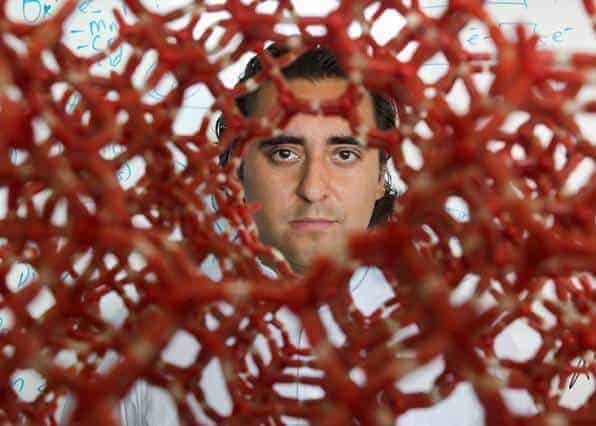Yuriy Román knew that to change the future of catalysis he’d have to cross the boundary between chemical engineering and materials science.
As a boy growing up in Mexico City, Yuriy Román was curious about how things worked. He’d go to his backyard and mix chemicals in the detergents his mother used to wash clothes to try to understand why some combinations worked and others didn’t. His academic trajectory, driven in part by an interest in sustainability, led him to graduate studies at Professor James Dumesic’s laboratory at the University of Wisconsin at Madison. Dumesic is one of the world’s leading researchers in the field of biofuels and biomass chemistry.
Today, Román leads a research group in MIT’s Department of Chemical Engineering. The core of his research is the catalytic conversion of the inedible parts of plant matter, such as cellulose and lignin, into chemicals useful for making fuels and substances like plastics, adhesives, lubricants, detergents, fertilizer, and pharmaceuticals. Catalysts are materials that induce or accelerate chemical reactions, and they’re often the key to making chemical processes industrially viable. For decades, research and development in catalysts has focused on making them faster and cheaper. The more active the catalytic material, the faster the chemical reactions. And the cheaper the catalytic material, the lower the cost of the end product of those reactions.
But with a changing climate and shifting fossil fuel economics, there’s a burning need to change the way the world makes and uses catalysts. Instead of just speed and cost, the field of catalysis needs to add versatility and efficiency, says Román. The drive to use plants rather than fossil fuels as feedstock means the catalytic materials used to process petrochemicals need to be adapted — or entirely new ones developed — to work with biomass. And the processes need to be as efficient as possible to minimize waste, Román says. “When we typically use the catalysts that we had developed for petrochemicals we can perform some of these transformations, but they are never as effective, they are never as efficient, and the materials are never as stable.”
One of the Román group’s recent advances remade a process that had traditionally taken multiple steps and used precious metals and high-pressure hydrogen gas to turn plant matter into g-valerolactone, a chemical used to make fuels and polymers. The new process happens in a single step and forgoes the use of precious metals and hydrogen gas. The key was fitting infinitesimal amounts of an acid into the microscopic pores of a highly porous material. The action of the acid removed the need for hydrogen gas.
The challenge to finding effective catalysts for biomass processing is that these processes always involve water, and water, in this case, ruins the acid. Using their materials-engineering skills, Román’s team tuned the pores of the material to be water repellent. “You can start doing some of this chemistry — this Lewis acid-based chemistry — in the presence of water,” says Román. “We use that to process different types of biomass-derived feeds to make new types of chemicals.”
Román knew that if he wanted to change the future of catalysis he’d have to cross some boundaries, particularly the boundary between chemical engineering and materials science. Before coming to MIT, Román joined the laboratory of Caltech Professor Mark Davis, where he did cutting-edge research on producing and analyzing microporous and mesoporous materials, which are types of materials commonly used as catalysts.
Developing catalysts used to mean doing kinetics and reactivity studies — the stuff of traditional chemical engineering. Now, cutting-edge catalysis research requires tools and skills from a range of disciplines, including spectroscopy, materials design, and computational modeling. “Boundaries between the different fields are really fading, and I think this is something that’s really important to embrace,” says Román. “This is something that I feel is very specific to MIT, in that the barriers to interact with people from different departments are low,” he says. “As we start working at the interfaces of fields, we should begin to see new game-changing discoveries.”


